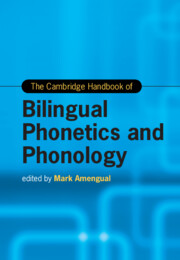Book contents
- The Cambridge Handbook of Bilingual Phonetics and Phonology
- Cambridge Handbooks in Language and Linguistics
- The Cambridge Handbook of Bilingual Phonetics and Phonology
- Copyright page
- Dedication
- Contents
- Figures
- Tables
- Contributors
- Acknowledgments
- Introduction Bilingual Phonetics and Phonology
- Part I Approaches to Bilingual Phonetics and Phonology
- Part II Theoretical Models of Bilingual Phonetics and Phonology
- Part III The Phonetics and Phonology of the Bilingual Child
- Part IV The Phonetics and Phonology of the Bilingual Adult
- Part V The Diversity of Bilingual Speakers
- 22 The Phonetics and Phonology of Early Bilinguals
- 23 The Phonetics and Phonology of Adult L2 Learners in the Classroom
- 24 The Phonetics and Phonology of Adult L2 Learners After Study Abroad
- 25 The Phonetics and Phonology of Heritage Language Speakers
- 26 The Phonetics and Phonology of Indigenous Language Bilinguals
- 27 The Phonology of Bimodal Bilinguals
- 28 Comparing Bilingual and Trilingual Phonetics and Phonology
- Part VI Variables and Outcomes of Bilingual Speech
- Index
- References
25 - The Phonetics and Phonology of Heritage Language Speakers
from Part V - The Diversity of Bilingual Speakers
Published online by Cambridge University Press: 14 November 2024
- The Cambridge Handbook of Bilingual Phonetics and Phonology
- Cambridge Handbooks in Language and Linguistics
- The Cambridge Handbook of Bilingual Phonetics and Phonology
- Copyright page
- Dedication
- Contents
- Figures
- Tables
- Contributors
- Acknowledgments
- Introduction Bilingual Phonetics and Phonology
- Part I Approaches to Bilingual Phonetics and Phonology
- Part II Theoretical Models of Bilingual Phonetics and Phonology
- Part III The Phonetics and Phonology of the Bilingual Child
- Part IV The Phonetics and Phonology of the Bilingual Adult
- Part V The Diversity of Bilingual Speakers
- 22 The Phonetics and Phonology of Early Bilinguals
- 23 The Phonetics and Phonology of Adult L2 Learners in the Classroom
- 24 The Phonetics and Phonology of Adult L2 Learners After Study Abroad
- 25 The Phonetics and Phonology of Heritage Language Speakers
- 26 The Phonetics and Phonology of Indigenous Language Bilinguals
- 27 The Phonology of Bimodal Bilinguals
- 28 Comparing Bilingual and Trilingual Phonetics and Phonology
- Part VI Variables and Outcomes of Bilingual Speech
- Index
- References
Summary
Heritage language speakers, or heritage speakers in short, are early sequential or simultaneous bilinguals whose home language, generally a diasporic or an indigenous language, differs from the majority language of the society. The goal of this chapter is to provide a comprehensive background of heritage speakers and their sound systems. It includes a literature review on the phonetics and phonology across heritage languages, particularly those of children of immigrants, in various majority language contexts. The chapter first describes heritage speakers and the general characteristics of their language learning experiences and outcomes. It then reviews studies examining heritage speakers’ global accent and factors contributing to perceived heritage accent. It also presents areas of divergence that have been found in the production and perception of heritage language segments and prosody. Lastly, the chapter synthesizes the findings, discussing common patterns observed in heritage language phonetics and phonology, and suggests areas for future research.
Keywords
- Type
- Chapter
- Information
- The Cambridge Handbook of Bilingual Phonetics and Phonology , pp. 560 - 583Publisher: Cambridge University PressPrint publication year: 2024

